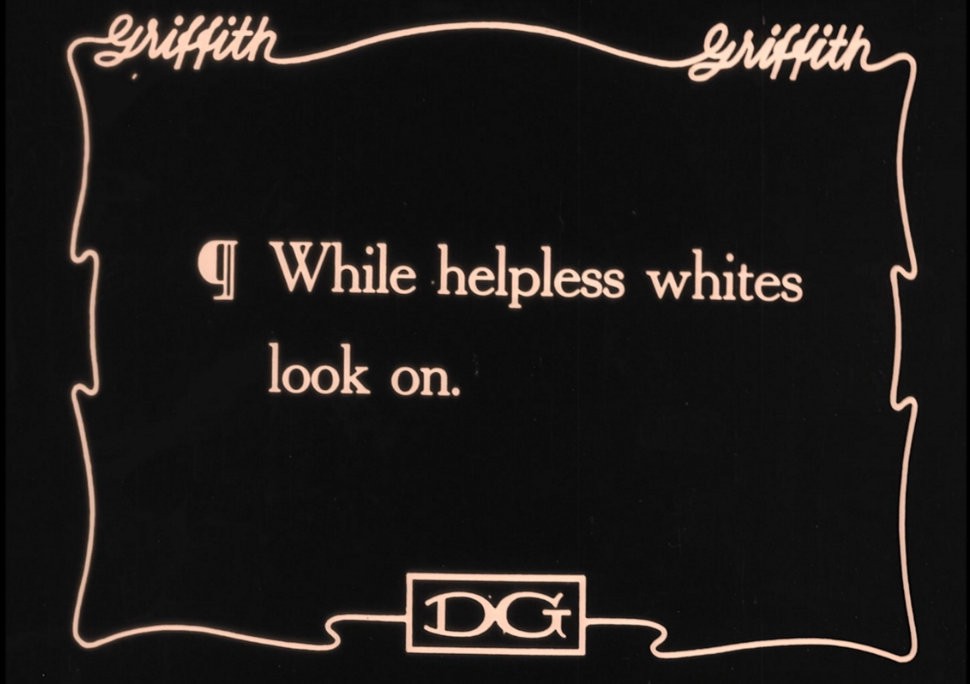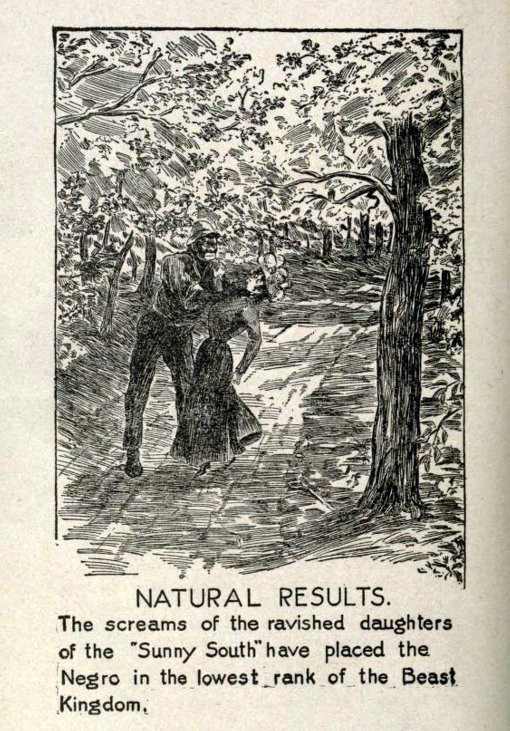There is so much bad history surrounding the ?The Irish were slaves too? meme that one could write a 100,000 word corrective and still have much left to debunk. Here I target one of the most racist aspects of the meme which claims that female Irish servants were ?forced to breed? with enslaved African men in British American colonies.
This is part three of my series debunking the ?Irish slaves? meme.See Part One, Two, Four, Five, Six and Seven.
 from The Birth of a Nation (1915)
from The Birth of a Nation (1915)
Myth: In 17th century Barbados (and elsewhere) Planters forcibly bred female Irish servants with male African slaves. This practice was so widespread that it had to be banned as it was impacting on the profits made by slave trading companies.
Some Examples
?White woman in particular were singled out for this punishment in the fields. Sometimes, to satisfy a perverted craving, the mulatto drivers forced the women to strip naked before commencing the flogging?[…]..while the women were weeding in the fields in that condition, the drivers often satisfied their lust by taking them from the rear.? ? Sean O?Callaghan, To Hell or Barbados: the Ethnic Cleansing of Ireland (2000)
?Some of the physically larger blacks were made guards and were given certain privileges, namely Irish women. There had been several Irish killed trying to protect the Irish women from being assaulted by these savage blacks.? ? Lawrence R. Kelleher, To shed a tear ? A story of Irish slavery in the British West Indies (2001), 73
?The settlers began to breed Irish women and girls with African men to produce slaves with a distinct complexion. These new ?mulatto? slaves brought a higher price than Irish livestock and, likewise, enabled the settlers to save money rather than purchase new African slaves. This practice of interbreeding Irish females with African men went on for several decades and was so widespread that, in 1681, legislation was passed ?forbidding the practice of mating Irish slave women to African slave men for the purpose of producing slaves for sale.? In short, it was stopped only because it interfered with the profits of a large slave transport company.? ? John Martin, The Irish Slave Trade ? the Forgotten ?White? Slaves (2008), GlobalResearch.ca
?This African would serve as a stud for the inexpensive Irish women slaves?[these breeding programs were stopped] because it was reducing the profits of the Royal African Company?[but] due to the profitability of these breeding programs the practice continued until well after the end of Ireland?s ?Potato Famine?. ? Guy Nixon, Slavery in the West: The Untold Story of the Slavery of Native Americans in the West (2011), 12
?Female Irish slaves were raped by their owners and bred to male African slaves to produce offspring who would grow into big, strong, mulatto slaves.?Maggie Plummer, author of Spirited Away ? A Novel of the Stolen Irish, Lake County writer examines Irish enslavement in historical novel, The Missoulian (2012)
??the black or mulatto overseers also often forced the [Irish] women to strip while working in the fields and often used them sexually as well.? ? Radio 2 Hot, The Irish Slaves ? What they will never, ever tell you in history class (2013), radio2hot
??the most unfortunate of these young [Irish] girls were taken to stud farms to be bred with the most favoured of the black slaves.? ? Jenifer Dixon, To Hell or Barbados: Was life for the Irish slave worse than that of the African slave?, The Barnes Review (Sept/Oct 2013), 16. N.B. The Barnes Review is journal dedicated to Holocaust denial.
?There are even documents of parentage saved from the archives of the Montserrat Library during the June 1977 volcanic eruption that destroyed much of the island. These documents read like animal pedigree papers, showing the pairing of young Irish girls with Mandingo warriors to breed a better slave, more capable of working in the burning sun.? ? Mike McCormack, Ancient Order of Hibernians, History Ireland Magazine, September/October 2017, 12
 from Charles Carroll?s notoriously racist book ?The Negro a Beast? (1900)
from Charles Carroll?s notoriously racist book ?The Negro a Beast? (1900)
Debunked: There is no evidence for any of these claims in the British West Indies and the British North American colonies. These ahistorical claims are part racialised sadomasochistic fantasy and part old white supremacist myth la The Birth of a Nation that heighten racist sentiment in the ?Irish slaves? meme. Furthermore, the racists who promote this propaganda will be very interested to hear that a microhistory which the meme misrepresents is a famous case where a ?free born? Irish woman loved and willingly married an enslaved African man.
In Barbados, the colony where the meme is mostly centred, the racial line was generally enforced by custom and (I repeat) there is no evidence here of any ?forced breeding? program of white female servants and black male slaves. Conversely, voluntary unions between white female servants and black slaves, while rare, did occur in some colonies. If we review the British American colonies as a whole in the seventeenth and eighteenth centuries we can reasonably conclude that the range of laws enacted to prevent intermarriages were a reaction to this fact rather than preemptive legislation. After researching this in some detail I conclude that the false narrative refers to legislation passed in 1681 in Colonial Maryland. The colonists in Maryland, as in other nascent British colonies, discouraged marriages and sexual relations between white and black. In 1664 they codified in law that slavery was race-based, perpetual and hereditary. This positive law also sought to strictly enforce the colour line by severely punishing free white women who married or had sexual relations with enslaved black men.
An act concerning Negroes and other slaves* (1664)
?Be it enacted by the Right Honorable the Lord Proprietary by the advise and consent of the upper and lower house of this present Generall Assembly, that all Negroes or other slaves already within the province, and all Negroes and other slaves to be hereafter imported into the province, shall serve durante vita [hard labour for life]. And all children born of any Negro or other slave shall be slaves as their fathers were, for the term of their lives. And forasmuch as divers freeborn English women, forgetful of their free condition and to the disgrace of our nation, marry Negro slaves, by which also divers suits may arise touching the issue of such women, and a great damage befalls the masters of such Negroes for prevention whereof, for deterring such freeborn women from such shameful matches. Be it further enacted by the authority, advise, and consent aforesaid, that whatsoever freeborn woman shall marry any slave from and after the last day of this present Assembly shall serve the master of such slave during the life of her husband. And that all the issue of such freeborn women so married shall be slaves as their fathers were. And be it further enacted, that all the issues of English or other freeborn women that have already married Negroes shall serve the masters of their parents till they be thirty years of age and no longer.?
By criminalising interracial marriages British Colonists thus wished to ringfence the ?white? and ?Christian? community as the preeminent colonial identity. As Winthrop Jordan summated, their attacks on miscegenation, which can be traced through their laws and correspondence, drip ?with distaste and indignation.? They particularly focussed on controlling the sexual freedom of the white female population, and their patriarchal justice system treated miscegenation between white men and enslaved black women as a far less important issue.
Mixed Race America and the Law
For the first time in United States history, the Year 2000 census allowed people to check more than one box to identify?
books.google.ie
?Irish Nell?The remarkable marriage of Eleanor Butler (an Irish servant) to Charles (an enslaved African) forced the administrators of this colony to rewrite this law. This marriage raised new concerns about such ?shameful matches? being tolerated by leaders in the community. It was not enough to only punish the ?disgraceful? woman, now those in positions of influence who allowed interracial marriages were also targeted. Its broader aim was clear: colonial society in Maryland was responsible for enforcing their relatively new institution of racialised perpetual hereditary chattel slavery and for policing its racist foundations.
The Marriage
Eleanor Butler, known as ?Irish Nell?, was an Irish servant who had been brought to Maryland by Lord Baltimore in the late 1670s. She completed her indenture and was a free woman. She served Major William Boarman in St. Mary?s Parish. Boarman was a prominent Catholic planter in the colony, mentioned at a Puritan court in 1655 as confessedly being a ?Roman Catholick?borne and bred so.?
The Maryland Semmes and Kindred Families
More than half a century ago, Raphael Thomas Semmes of Georgia bequeathed his collection of genealogical data?
books.google.ie
In August 1681 Eleanor was married to Charles, one of Boarman?s slaves. This ceremony was performed on the plantation grounds by Father Hubbert, a Catholic priest. The wedding was attended by a large crowd of guests and well wishers. According to the 1664 law her punishment was that she would be enslaved alongside her husband, as long as he was alive. But worse than that, their children were to be slaves. From 1749 to 1787 the descendants of this marriage sued for their freedom multiple times on the basis that Eleanor was a white woman. They eventually won and were granted their freedom. The Boarmans were ordered to pay damages. The court depositions (27 May 1767) reveal vital details about this case. It appears that Lord Baltimore tried to prevent the marriage. As the Governor of the colony he was disturbed that a white Catholic woman would marry a black slave by choice, and aghast that some members of the elite Catholic ruling class apparently endorsed the marriage.
Sixty-three year old Thomas Bowling, who personally knew two of Eleanor?s children, presented hearsay evidence. He told the court that his mother had spoken to Eleanor about her marriage. He relayed the following account of what happened when Lord Baltimore warned Butler about the consequences of this marriage
??if she would marry a white man her children might be a Credit in the world, otherwise they wou?d be in slavery, upon which she fell a crying, and said it was to her Choice, she wou?d rather have Charles than have your Lordship, upon which he said marry him if you will and so were married??
All of the depositions generally support the proposition that Butler broke the racial line by choice and that she was willing to be enslaved alongside her husband out of personal conviction and not coercion.
New LawA month after the wedding Lord Baltimore is thought to have influenced the passing of a new law which sought to further prevent such interracial marriages in future. It imposed a financial penalty on Masters or mistresses who allowed their female servants to marry male slaves. It also freed female servants from their indenture if they were permitted by their Master to marry a slave. Although there is no evidence of this practice, it is plausible that some planters in Maryland (from 1664?1681) may have encouraged marriages between servants and slaves, as chattel slavery was passed down on the paternal line at this time in this colony. But this would have breached their own laws, customs and ideologies rather than being some sort of ?forced breeding? program that is erroneously suggested in the mythology. Thus to remove this incentive the new law repealed the 1664 law, stating that in future the children in a marriage between a white woman and a black slave would be free. Additionally, this adjustment put the onus on the planters to prevent such relationships as these legal provisions, if enforced, could seriously undermine their labour force, both servants and slaves. Tellingly the law?s central targets remained the ?morals? and sexual freedoms of white women.
An Act Concerning Servants and Slaves (1681)
?Forasmuch as, divers free-born English, or white women, sometimes by the instigation, procurement or connivance, of their masters, mistresses, or dames, and always to the satisfaction of their lascivious and lustful desires, and to the disgrace not only of the English, but also of many other Christian nations, do intermarry with negroes and slaves, by which means, divers inconveniences, controversies, and suits may arise touching the issue or children of such free-born women aforesaid; for the prevention whereof for the future, be it, &c., enacts that if the marriage of any woman-servant with any slave shall take place by the procurement or permission of the master, such woman and her issue shall be free, and enacts a penalty by fine on the master or mistress and on the person joining the parties in marriage.?
 An ?Irish Fascist? on Stormfront looking to buy a copy of Carroll?s racist tract
An ?Irish Fascist? on Stormfront looking to buy a copy of Carroll?s racist tract
This is part three of my series debunking the ?Irish slaves? meme.See Part One, Part Two, Part Four , Part Five and Part Six
 CLICK HERE
CLICK HERE

